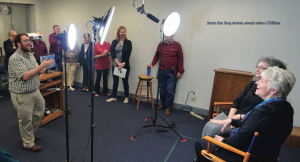 The University of Mississippi Libraries recently launched STUDIOone, an interactive video recording and editing studio housed in the J.D. Williams Library.
The University of Mississippi Libraries recently launched STUDIOone, an interactive video recording and editing studio housed in the J.D. Williams Library.
The studio, which offers a “one-stop shop” for video recording and editing needs, is available to all university affiliates.
While there was not one specific need for the studio, “we recognized that instructors are creating multimodal assignments and that students may want to use equipment outside of their phone or use editing software that may not be readily available,” said Brian Young, engineering reference librarian.
The studio offers uses a simplified recording and editing option that can be easily used without any previous video experience. The studios concept was based on the Penn State One Button Studio model.
“STUDIOone was designed to allow users to make high-quality videos in a controlled environment without having to know anything about video cameras, lighting or sound,” said Kevin Herrera, the university’s head of library information technology.
All users need is a flash drive to use the video recording studio. The simplified studio model allows individuals to create video projects without any previous lighting and camera experience. Additionally, the studio is equipped with a projector, which allows users to display visual presentations in their videos.
“Green screen technology is one of the unique features available in STUDIOone,” Herrera said. “If users record videos using the green screen option, they can later replace the green background with another background image or video. In addition to providing the equipment to record green screen videos, the studio also provides a number of software packages for video editing.”
While video editing may not come naturally to some individuals, STUDIOone contains software for all user levels. The software ranges from quick editing tools to full eLearning packages for more complex programs. Users are also given the option to choose between Windows and OSX operating systems.
If a university affiliate is interested in using STUDIOone, they must first contact the library to make an initial reservation. After their first shoot, individuals can make additional reservations though an online system.
The studio is a great resource for faculty, staff and students. It affords them the option to practice for a presentation, complete a video assignment, present a research paper and even record a lecture.
“STUDIOone is helping students to integrate digital media into their course-work, career planning, and student life,” said Richard Forgette, a professor of political science. “Faculty are already beginning to make use of this resource with new class assignments.”
The studio was funded in part by the Office of the Provost, the University Libraries and donations though an Ignite Ole Miss crowdfunding campaign, which included a generous gift from the Department of Intercollegiate Athletics.
“I have told colleagues that I am much more excited to see what the university community does with STUDIOone that I have not thought about,” Young said.
For more information on STUDIOone, visit http://libraries.olemiss.edu/connect/studio-one.